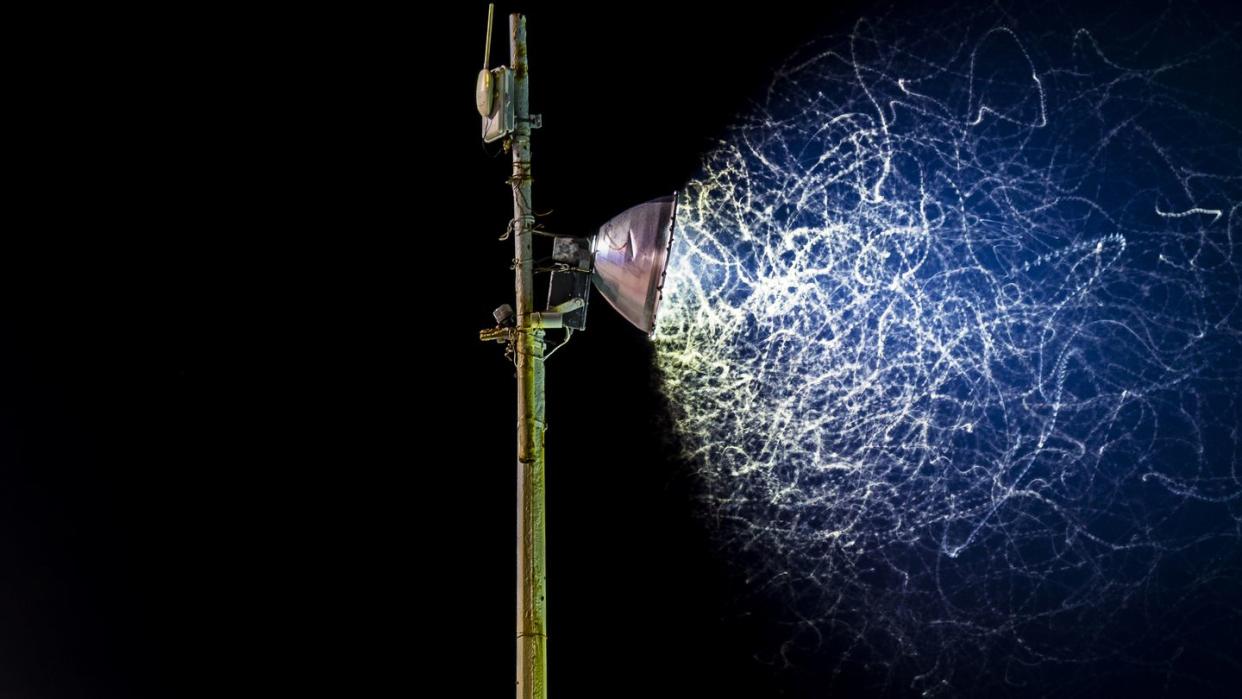The Real Reason Bugs Keep Flying Into Artificial Light and Accidentally Dying

"Hearst Magazines and Yahoo may earn commission or revenue on some items through these links."
A research study has discovered, for the first time, just what happens when an insect approaches artificial light.
Flying insects turn their tops toward the light source to help maintain altitude, but this traps them in a pattern.
The instinct to orient in specific ways toward the light can also lead to crashes.
The pull of the artificial light from a few feet away is famously oh so alluring to flying insects. Now we finally know why.
In a new study published in Nature Communications, a team from Imperial College of London’s Department of Bioengineering tracked the movement of flying insects around artificial light in both lab settings and in Costa Rica field experiments. After filming and analyzing the movements, the researchers found that what we believed all along... wasn’t true.
No, insects aren’t attracted to and drawn in by light from far away. Instead, they become trapped by the artificial light if they happen to fly too close. It’s all part of the insects’ efforts to remain right side up.
“Contrary to the expectation of attraction, insects do not steer directly toward the light,” the authors wrote. “Instead, insects turn their dorsum [top] toward the light, generating flight bouts perpendicular to the source.” In a natural world, this tilts the top of the insect toward the brightest visual hemisphere to maintain proper flight altitude and control, ensuring a safe flight relative to the ground. We call it dorsal light response. “Near artificial courses, however, this highly conserved dorsal-light response can produce continuous steering around the light and trap an insect.”
The natural response to an unnatural light source is enough to create seemingly erratic flight paths of insects near lights, trapping them in a sort of holding pattern. According to the team, this constitutes the “most plausible model for why flying insects gather at artificial lights.”
They don’t want to get stuck, but their insect bodies give them no choice.
The team used high-fidelity cameras during field experiments in Costa Rica and then conducted in-lab testing at Imperial. The team mounted eight markers on five species of insects—the common darter and migrant hawker dragonflies were part of the mix—and used motion-capture cameras to track behavior around UV LED bulbs, a UV-Blue Actinic tube, and a cool white LED bulb.
The light sources all “significantly altered” the insects’ ability to control their bearings, as they continually attempted to tilt their backs toward the light.
“Flying animals need a reliable way to determine their orientation,” Samuel Fabian, lead author of the study, said in a statement, “especially relative to the direction of gravity. With help from new technologies that enable us to track the movements of tiny insects in difficult and dark conditions, we were able to understand how these insects behave around different light sources.”
Through the study, the team eliminated the theories that insects are attracted to light from far away, that the light blinds the insects, or that heat plays a role in drawing the insects closer.
And just hovering around light isn’t the only result of this artificial illumination conundrum. The team found that the artificial situations could cause additional strange behaviors. What appears to the untrained eye as the flocking of insects toward the light is often orbiting—they maintain a stable, circular flightpath around the light, trapped by the instinct to right themselves and unable to break free. There are also times where the movements cause stalling after a steep climb. Lights in unique locations, such as low to the ground, can also cause inversions in which the insects flip upside down thinking they is righting themselves, only to crash to the ground.
Insects consistently directed their dorsal axis toward the light source, even if this prevented sustained flight and led to a crash. In a YouTube video produced by Nature, Fabian said that we “get insects plummeting out of darkness onto the floor” due to the natural phototaxis and “not producing enough flight force to maintain flight course.”
The team hopes to take a next step in the study and figure out how distance changes the impact of light. “We know what’s happening at one meter from a light,” Fabian said, “but what’s happening at 100 meters?”
“I hope this research motivates us to think twice about the light we throw around at night,” Fabian said. “Light at night is pollution, and we need to think of it as such.”
You Might Also Like

